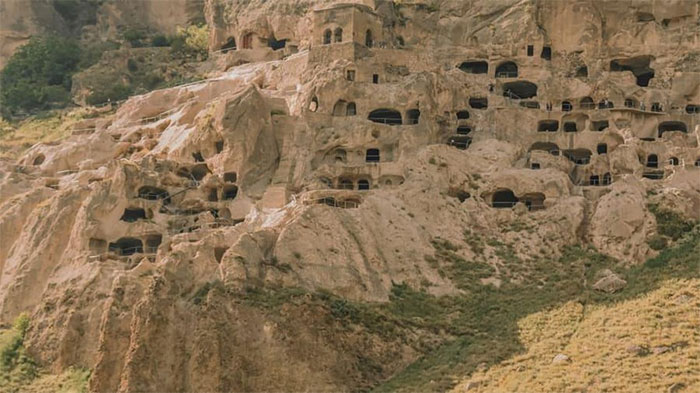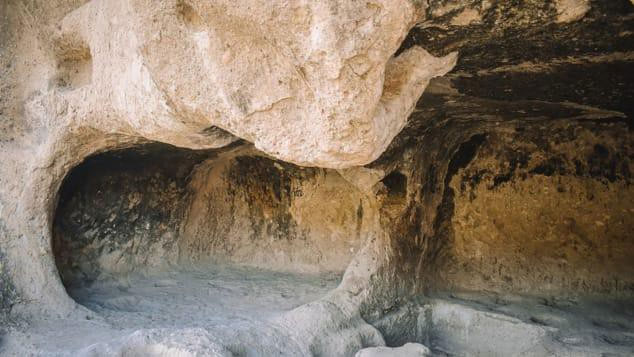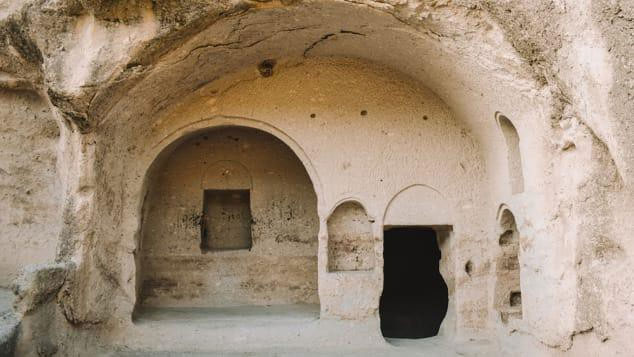Scattered across the Erusheti mountain slopes in the Samtskhe-Javakheti region of Georgia, the impressive cave city of Vardzia once encompassed 6,000 rooftops spread over 19 tiers.
From the 3,000-year-old Uplistikhe to the 6th-century David Gareja Monastery, and the long-forgotten dwellings of Samshvilde, all the cave sites in Georgia are astonishing, but none dominate quite like Vardzia, the mysterious cave city.

Rooftops built into the rock in the city of Vardzia, Georgia.
Perched on the Erusheti slopes, nestled above a lush valley accentuated by the Kura River, Vardzia is the most notable cave city in Georgia.
In ancient times, this area was situated on a rocky outcrop featuring 6,000 rooftops spread over 19 levels, including 25 wine cellars, a nunnery, 15 chapels, and a pharmacy, all interconnected to form a vibrant medieval city and monastery.
Secret Escape Tunnels and Confusing Dead Ends

Over 500 caves of the city of Vardzia still exist today.
Initially, it was established and constructed as a fortress in the 12th century under the reign of King Giorgi III, but it was his daughter who created a city with a series of caves and complex rooms carved deep into the Erusheti Mountain, including a secret escape tunnel and a series of dead-end houses to confuse enemies.
It quickly evolved from a modest fortress into a monastery, a cultural center, and a vast military stronghold. Vardzia was home to around 2,000 monks, tens of thousands of residents, and boasted fertile terraced fields and a complex irrigation system.
Queen Tamar the Great, the legendary fierce and powerful monarch, during her 30-year reign, propelled Georgia to political and territorial prosperity, her rule extending throughout the region.
Vardzia once housed up to 2,000 monks. Approximately 500 caves still remain today.

Dining room of a house in the cliff at Vardzia
However, Vardzia’s golden age was relatively short-lived. In 1283, an earthquake shook the region, destroying over 70% of the city and collapsing the outer walls in an avalanche.
The monastic community survived for another 300 years until it was persecuted.
About 500 caves remain, including a meticulously carved apothecary that remains intact and wine cellars with ancient brewing vessels still placed below as if untouched by time.
Deeper within the mountain lies a labyrinth of pristine tunnels—some nearly 200 meters long, interconnected in an ancient network.
The most distinctive structure is the massive bell tower jutting out from the top of a rocky terrace. It retains most of its original beauty, although the bell was taken during a Mongol raid.
Vardzia’s most impressive site is the Church of the Dormition with its double dome, the bell hanging invisibly carved into the mountainside. Inside are stunning frescoes, including one of the four remaining depictions of Queen Tamar.
A natural spring hidden deep within the tunnels is likened to the tears of Queen Tamar, where you will find a pool filled with water from the rocks above.
Opposite Vardzia is the Vardzia Cavetown Viewpoint. This is a fantastic stop to admire the entire site from afar. Nearby is Vanis Kvabebi (Vani Caves), a lesser-known stone monastery intricately carved just a 10-minute drive from Vardzia. Eager climbers can reach this site via a series of wooden ladders leading to a small church with a white dome, enjoying panoramic views of the valley.
Not far from Vanis Kvabebi is the Tmogvi Fortress, a long-forgotten castle with stained frescoes and crumbling towers.
|
Vardzia is located in Samtskhe-Javakheti, a region in southern Georgia bordering Turkey and Armenia, known for its vibrant culture, landscapes, and cuisine. In the northern half of the region, you will find Borjomi— a spa town famous for its lush forests, hot springs, and bottled mineral water. Just over four hours’ drive from the capital Tbilisi, a journey through the dense forests of Borjomi and the golden Akhaltsikhe Fortress will take you to Vardzia. |
















































